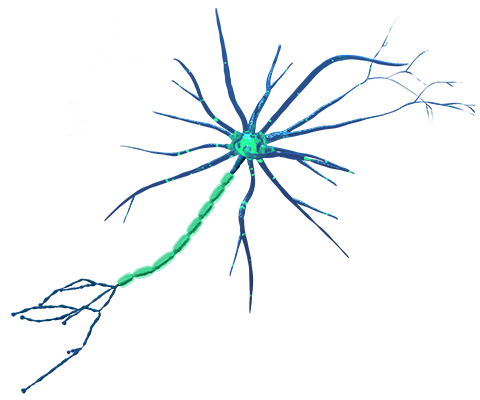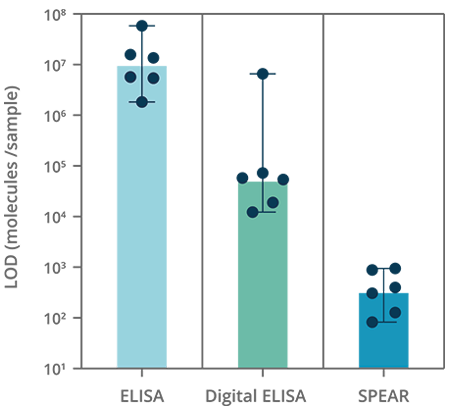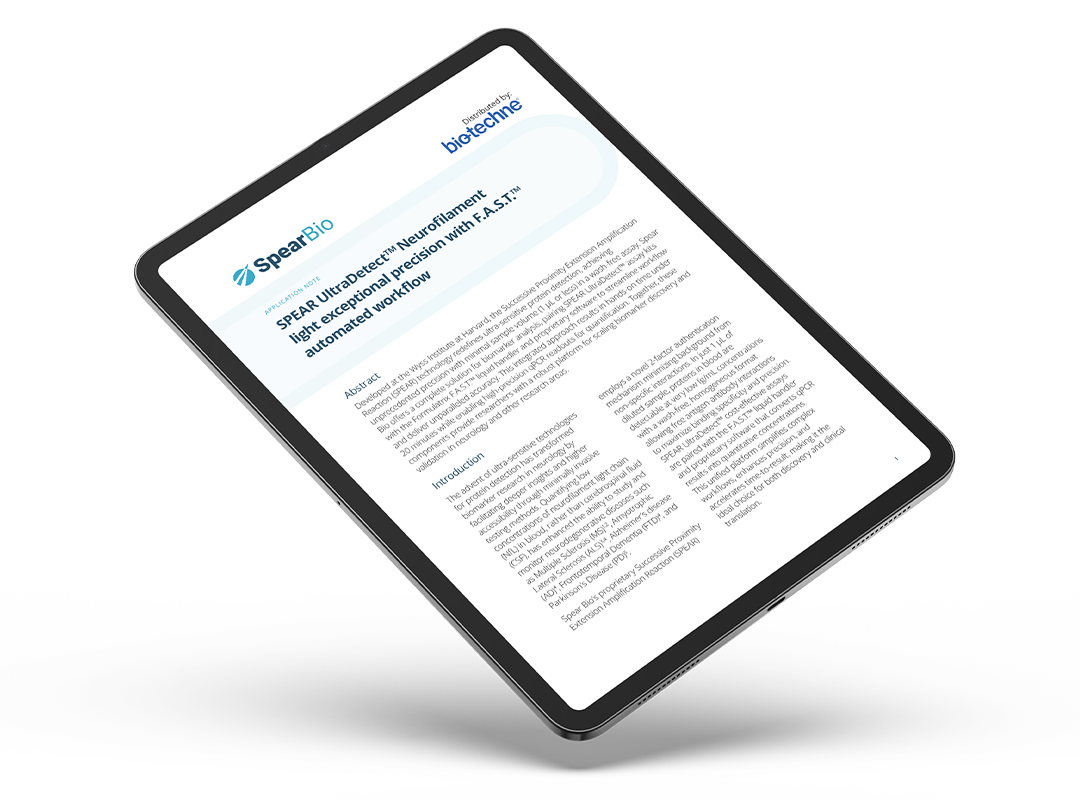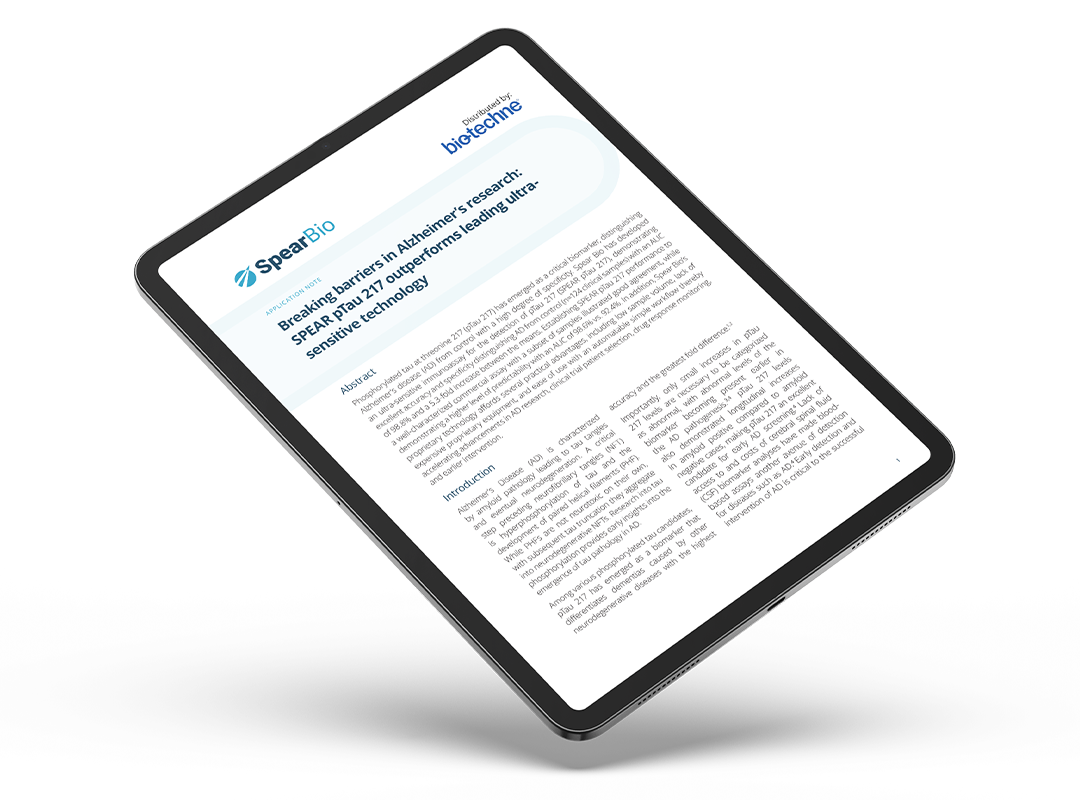
At Bio-Techne, we believe collaboration drives scientific innovation, equipping researchers with the tools needed to advance disease understanding and therapeutic development. With that vision in mind, we have partnered with Spear Bio to distribute next-generation ultra-sensitive immunoassays, enabling the detection of low-abundance biomarkers in neurology, and other disease areas.
This partnership brings together Bio-Techne’s global reach and immunoassay expertise with Spear Bio’s breakthrough platform, offering unmatched sensitivity for detecting key disease biomarkers. Together, we are advancing the future of biomarker detection, enabling discoveries that drive scientific and medical progress.
About SPEAR Technology
Successive Proximity Extension Amplification Reaction (SPEAR) technology is a fundamentally different approach to addressing the sensitivity limitations and complexity of conventional immunoassays. A homogeneous immunoassay technology with a unique two-factor authentication mechanism, SPEAR is capable of attomolar detection with 1 µL of diluted sample. This mechanism eliminates background and ensures signal is generated only from target-specific co-localization events without any wash steps.
Spear Bio has leveraged this technology to offer SPEAR UltraDetect assays delivering researchers the unparalleled sensitivity, specificity, precision, and robustness required for advanced analysis of low-abundance biomarkers.
How can SPEAR UltraDetect Assays help you?
Consistent detection and quantification of important protein-based neuro biomarker targets in blood is often challenging due to their low abundance. SPEAR technology overcomes this hurdle, offering a platform with unparalleled sensitivity, specificity. precision, and robustness.
- Unparalleled Sensitivity: SPEAR is the only homogeneous ultrasensitive immunoassay platform, capable of attomolar detection with 1 µL diluted sample.
- Unparalleled Specificity: SPEAR’s two-factor authentication ensures target-specific binding, and its homogeneous format ensures no false positives associated with non-specific binding to solid surfaces.
- Unparalleled Precision: The wash-free workflow makes SPEAR UltraDetect easy to automate, driving highly precise measurements from 1 µL of diluted sample.
- Unparalleled Robustness: SPEAR UltraDetect assays are compatible with a majority of the large qPCR installed base demonstrating consistent performance across different qPCR platforms and formats.
A Simple, Scalable Immunoassay Workflow
The SPEAR UltraDetect workflow is homogeneous, streamlining protein quantification by eliminating solid surface immobilization and error-prone wash steps. Its unique two-factor authentication mechanism reduces background, driving exceptional sensitivity and specificity. With a three-step, wash-free workflow, SPEAR UltraDetect assays are an easily automated, scalable solution for biomarker detection.

SPEAR UltraDetect Benefits
SPEAR UltraDetect pTau231 delivers superior sensitivity over competitive platforms offering an industry leading, verified plasma quantifiability of 97% of healthy samples. In a study comparing a cohort of amyloid positive and amyloid negative samples, SPEAR UltraDetect quantified all plasma samples – including amyloid negative samples, with mean CV of 5%.
SPEAR UltraDetect pTau 231 quantified all plasma samples with a mean CV of 5%.
The SPEAR UltraDetect Neurofilament light (NF-L) and GFAP assays offer unparalleled precision. With verified mean CV of less than 5% while accurately quantifying 100% of healthy patient samples well above LLOQ across different matrices. To demonstrate this experimentally, we tested SPEAR UltraDetect NF-L and GFAP assays on healthy serum and EDTA plasma samples, (demonstrating mean intra-plate %CV of 3.2% and 3%.

SPEAR UltraDetect GFAP Assay Precision (1 uL diluted sample)
SPEAR UltraDetect GFAP intra-plate mean CV of 3%.
The homogeneous assay format of SPEAR UltraDetect also maximizes the specificity of biomarker measurements, leading to exceptional clinical performance. In a cohort including CSF-Confirmed and amyloid PET-Confirmed Alzheimer’s Disease (AD), and Non-AD patients, the SPEAR UltraDetect pTau217 assay resulted in a 5.41x fold-difference between control and AD groups with 1uL of diluted plasma sample and area under the curve (AUC) of 0.989 for CSF-confirmed plasma samples and 0.984 for PET-confirmed plasma samples, demonstrating industry-leading performance in the ability to classify AD patients.

SPEAR UltraDetect pTau217 ROC for CSF-Confirmed & Pet-Confirmed Plasma Samples
ROC analyses, comparing SPEAR UltraDetect pTau217 on CSF-confirmed and PET-confirmed Plasma samples.

SPEAR UltraDetect pTau 217 (1 uL diluted sample)
SPEAR UltraDetect pTau217 testing on CSF-confirmed EDTA Plasma AD and non-AD (Control) including 48 non-AD and 40 AD. Amyloid PET confirmed EDTA plasma including 33 Amyloid negative (Control) and 28 Amyloid positive (AD).

How SPEAR Compares to Other High Sensitivity Technologies?
| Molecules of Protein Threshold for Detection | Antibody Affinity Requirement | Sample Volume | Dynamic Range | Assay Steps | Proprietary Instrument | |
|---|---|---|---|---|---|---|
| SPEAR | 10's | Low | 1 μL or less | >6 logs | 3 | No |
| Digital ELISA | 1,000's | High | 100 μL | 3-4 logs | >10 | Yes |
| Electro-Chemiluminescence Immunoassays (ECLIA) | 10,000's | High | 25 μL | 4 logs | >15 | Yes |
| Proximity Extension/Ligation Assay | 10,000's | Medium | 1 μL | 4 logs | >6 | No |
Ultra-Biomarker Detection for Neuroscience
- SPEAR UltraDetect pTau 231: pTau231 is a key phospho-epitope of the Tau protein that emerges early in Alzheimer’s disease pathology, making it an important predictive biomarker of disease for longitudinal studies and clinical trials. SPEAR UltraDetect pTau231 delivers unparalleled sensitivity in the quantification of healthy, pre-clinical samples, offering critical performance required for studying onset of disease.
- SPEAR UltraDetect pTau 217: pTau 217 is a widely used, high-contrast biomarker for amyloid status in Alzheimer’s disease. SPEAR UltraDetect pTau217 is a highly sensitive and specific assay enabling researchers to better differentiate plasma pTau217 from control and improve sample stratification.
- SPEAR UltraDetect GFAP: GFAP is a general biomarker of astrocyte reactivity across many neurological conditions such as TBI and stroke as well as an important correlate of neuroinflammation in Alzheimer’s disease. The SPEAR UltraDetect GFAP assay offers a highly sensitive and precise method for quantifying GFAP in blood-based samples.
- SPEAR UltraDetect Neurofilament Light (NfL): NfL is a biomarker for axonal damage that is widely used as an indicator of neurodegeneration across many conditions. SPEAR UltraDetect Neurofilament Light offers unparalleled sensitivity and precision for robust protein quantification across these use-cases.
Compatible with Different qPCR Instruments
SPEAR UltraDetect assays also demonstrate unparalleled robustness in their ability to deliver consistent performance across different qPCR platforms and formats. Using SPEAR UltraDetect Neurofilament light to demonstrate this value, data were successfully reproduced on multiple qPCR instruments and plate formats across different operators. The assay was run on 39 plasma samples across 96 and 384-well plate formats on a range of qPCR models: resulting in extremely consistent performance and a mean CV % of 4.3% across 10 combinations of instruments and formats, including Bio-Rad, Thermo Fisher Quant Studio 5,7 and 12K, and the Roche Light Cycler.
NFL qPCR Concordance
SPEAR UltraDetect NF-L showed consistent results across qPCR platforms and formats with just 4.3% CV.

Resources
SPEAR Technology: Precision with F.A.S.T. Automation
SPEAR Technology: Precision with F.A.S.T. Automation
Explore how SPEAR technology delivers superior sensitivity and specificity in detecting Neurofilament Light (NfL) compared to conventional immunoassays, enabling ultra-sensitive protein detection from sub-microliter serum or plasma samples.
A Scalable Solution for Measuring Low-Abundance Neurobiomarkers
A Scalable Solution for Measuring Low-Abundance Neurobiomarkers
Discover how ultrasensitive immunoassay platforms detect blood-based protein biomarkers of Alzheimer’s disease at fg/mL levels, enabling early prognosis, screening, and therapy monitoring.
SPEAR pTau 217 Immunoassay for AD Sample Differentiation
SPEAR pTau 217 Immunoassay for AD Sample Differentiation
Learn how the SPEAR UltraDetect™ pTau 217 immunoassay precisely distinguishes amyloid-positive Alzheimer’s disease samples from amyloid-negative controls.




